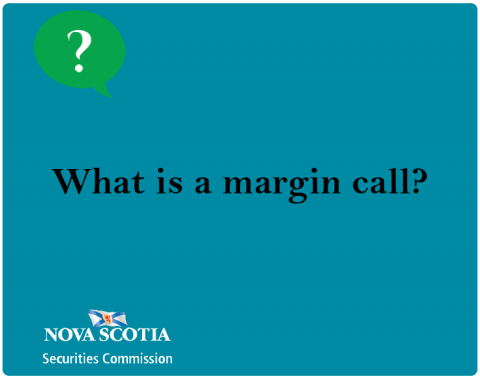Submitted by nsscadmin on

Last week we discussed margin accounts. This week we’ve been asked about a specific part of margin accounts, margin calls.
The Nova Scotia Securities Commission does not provide investment advice. We are not advising or recommending investors to use leverage. This post is simply to educate investors on how margin works so they can be an informed investor when working with their adviser and making investment decisions.
Use of margin accounts entail a high amount risk and the use of leverage and may not be suitable for you. You should consult with a registered investment advisor before considering opening a margin account.
A margin call takes place when the value of an investor’s margin account falls below the amount required by the broker. As we detailed last week, a margin account holds securities that were bought with a combination of the investor’s money and money borrowed from the brokerage.
In a margin account the investor’s equity in the investments is equal to the current market value of the investments minus the amount they have borrowed from the broker. A margin call occurs when the investors equity (calculated as a percentage of the total market value of the investments) falls below a required percentage. This required percentage is called the maintenance margin.
After a margin call is placed the investor must increase their equity percentage by adding more money to the account, or by selling some of their investments. The maintenance margin required can vary from brokerage to brokerage so make sure you know what yours will be before opening a margin account.
Here’s an example to show how a margin call might take place. An investor opens a margin account with $20,000 of their own money and $20,000 borrowed from their brokerage. With their $40,000 they purchase 400 shares in a company at a price of $100 per share. In our example the broker’s maintenance margin is 30 percent.
To figure out when a margin call would be initiated, we use the following formula:
Loan value / (1-0.30)
Using our example, this give us:
$20,000 / (1-0.30) = $28,571.43
If the value of the account drops below $28,571.43 a margin call would occur.
Here’s how that could potentially happen.
The price of the shares in the company drop drastically and fall to $55 per share. The investor’s 400 shares are now worth $22,000. This is well below the maintenance margin of $28,571.43. The investor must now make up the deficiency which is $6,571.43. They can do this by simply depositing money into the account, or by selling off some securities to reduce their margin amount.
As we said last week, investing through a margin account can be extremely risky. When you’re investing with borrowed money, margin risk is added to the equation. Make sure your risk tolerance and your finances can handle it before you decide to invest in a margin account.
